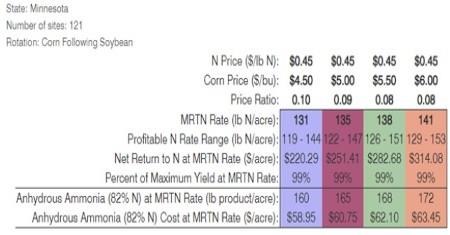By Jeff Vetsch
Fertilizer prices have increased dramatically since July of last year. Phosphates, MAP, DAP and liquids were the first fertilizers to increase last fall, followed by all nitrogen (N) sources beginning in January of this year. The largest percent increases were for anhydrous ammonia (70%), urea (50%) and UAN 32-0-0 (65%). Currently, these sources are priced about $735, $535 and $415 per ton, respectively, at a nearby fertilizer retailer in south-central Minnesota.
Corn Nitrogen Rate Calculator
So, how should rising nitrogen fertilizer prices impact corn farmers’ decision making for the 2022 growing season? We have an app for that! Well, actually, it’s a website: the Corn Nitrogen Rate Calculator. The calculator allows users to input both the corn price and the price of the N fertilizer of choice. Multiple prices can be input and compared as in the example below.
Example 1.
- Corn after soybean in Minnesota
- Anhydrous ammonia at $735 per ton
- Corn price varied from $4.50 to $6.00 per bushel
- The N rates are determined from a research database of over 120 corn after soybean N rate trials on medium- and fine-textured soils in Minnesota.
- In this example, the Maximum Return to Nitrogen (MRTN) rate ranges from 131 to 141 pounds of nitrogen per acre (lbs N/ac) due to the fluctuating corn price (the N price to corn price ratio ranges from 0.10 to 0.075).

Price ratio
Historically, when corn prices increase, nitrogen fertilizer prices follow suit. They often increase at similar rates, so the price ratio (N price divided by corn price) is usually around 0.10. Small changes in the price ratio, e.g. from 0.10 to 0.08, have a minor impact on the calculator’s recommended N rates. Furthermore, the acceptable ranges at these ratios (0.10 and 0.08) partially overlap one another. From a farmer’s perspective, these rate changes are relatively small and are not likely to influence their N rate decisions very much.
Nitrogen source considerations
A more interesting comparison is how N sources affect a grower’s bottom line.
Example 2.
- Corn after soybean in Minnesota
- If we fix corn price at $5.00 per bushel and adjust the N price based on current prices for ammonia, urea, UAN and ESN ($705 per ton), we find the price per pound of N is $0.45, $0.58, $0.65 and $0.78, respectively.
- These same sources would then result in MRTN rate recommendations of 135, 125, 122 and 114 lbs N/ac for ammonia, urea, UAN and ESN, respectively. (It’s important to note that ESN would likely be used in a blend with conventional urea. Therefore, the average price per pound of N would be less for the blend.)
- This example shows that, at current prices, N source may influence a farmer’s N rate decision.
In the previous example, the calculator showed it would be more profitable to apply less N if UAN is your source compared to ammonia. However, research in Waseca, Minnesota has shown that UAN can reduce corn yield occasionally compared with ammonia, even when UAN is incorporated. So, reducing the rate of UAN may not be more profitable. Applying the same N rate for both sources may be warranted. However, farmers are going to pay significantly more to use UAN than ammonia, assuming that the application costs are similar. (The ability to include a pre-emergent herbicide in with broadcast applications of UAN or impregnated on urea can offset some of the price difference and save time and trips across the field.)
How the ongoing drought could affect your nitrogen management plans
Another factor to consider is the continued drought throughout much of the Northern Corn Belt. If this weather persists, it is very likely that N uptake by the crop will be reduced. Less N uptake combined with minimal N loss (there is often very little leaching or denitrification in a drought year) usually results in greater quantities of nitrate remaining in the soil profile after harvest. If these conditions describe your fields, consider taking soil samples for nitrate this fall in western Minnesota or in April in south-central and southeast Minnesota. These samples can help you decide how much of an N credit to take, which could significantly reduce your N fertilizer rate for next year’s crop.
Nitrogen management in corn can be difficult and complicated. Utilizing as many tools as possible will assist you in making agronomic and environmentally sound management decisions.
Source : umn.edu